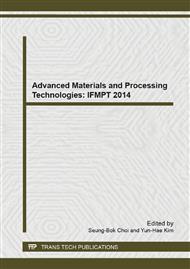p.510
p.517
p.522
p.526
p.531
p.538
p.543
p.547
p.557
Jet Stabilities in the Electrospraying of Macro-Molecules Solutions for Controllable Micro-Printing
Abstract:
Electrospraying (ES) is of great interest in research for its finely controlled delivery of biomaterials. This study investigated mechanisms involved in the electrospraying of biological macro-molecules which may cause spraying instabilities. Hyaluronan (HA) solutions with concentrations ranging from 1 to 5 w/v % (w in g and v in 100 ml) were prepared for spraying trials using nozzles with a size of 30 μm. In electrifying HA solutions with a high molecular weight of 2.1 MDa, controllable jets can be achieved only at the lowest concentration of 1 w/v %. Generally, further use of a sonication method to reduce the molecular size, stable cone jets can be performed relatively easily than using HA solutions of higher concentrations. The improvement of spray stabilities can be attributed to the reduction in viscosity of the solutions after the sonication. Steady micro-sized jets were observed during the ES process and the jet size was found to increase with the increase of both the molecular size and the concentration. Both parameters can be directly ascribed to the rheological property of the solutions. Results show that a suitable viscosity is critically important in stabilizing the electrospray of macro-molecules. A concentration reduction of HA molecules also happens during electrospraying, which indicates that there is a partial reflection of macro-molecules inside the Taylor-cone with the fluid motions during the spraying process. This partial reflection process is affected by molecular sizes, solution concentrations and spraying time.
Info:
Periodical:
Pages:
531-537
Citation:
Online since:
February 2014
Authors:
Price:
Сopyright:
© 2014 Trans Tech Publications Ltd. All Rights Reserved
Share:
Citation:


